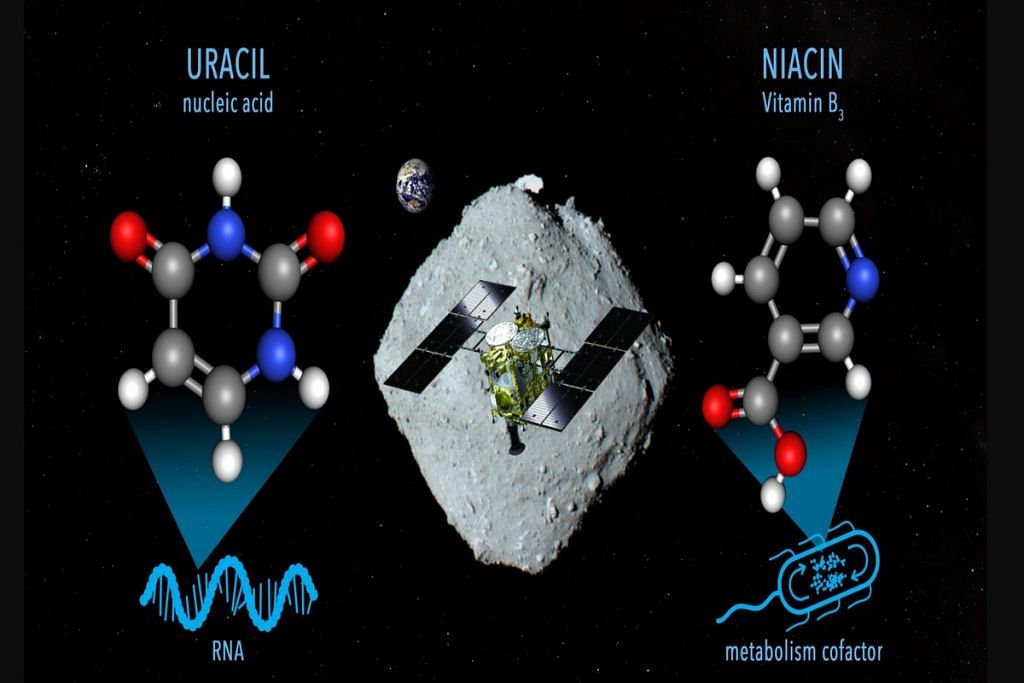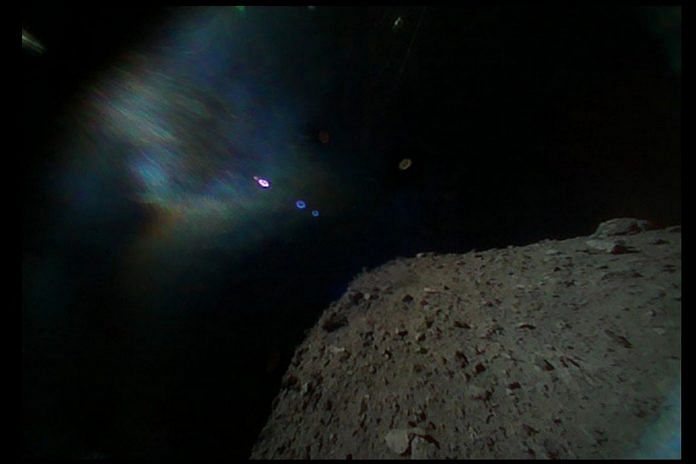Bengaluru: The hypothesis that comets and asteroids deposited the building blocks of life on Earth millions of years ago has received yet another boost. A team of scientists has discovered the presence of basic amino acids, crucial for forming RNA, in samples collected from the near-Earth asteroid Ryugu, adding to the growing evidence that the ingredients for life on Earth may have come from outer space.
The asteroid samples, collected by a Japanese-led space mission called Hayabusa2, have revealed the presence of various organic molecules, including uracil, one of the four nucleobases of ribonucleic acid (RNA). RNA is a molecule that is present in all living cells and plays a crucial role in turning instructions in DNA into proteins.
The latest findings are detailed in a paper, ‘Uracil in the carbonaceous asteroid (162173) Ryugu’, published on 21 March in the journal Nature Communications.
Last month, the initial analysis of samples brought back from this carbon-rich asteroid was published in the journal Science. The scientists had reported finding many organic molecules, including 15 amino acids — the building blocks of proteins. The authors had proposed that these compounds would have been created on the asteroid by the reaction of the surface ice to sunlight.
“These molecules can survive on the surfaces of asteroids and be transported throughout the Solar System,” the February paper, titled ‘Soluble organic molecules in samples of the carbonaceous asteroid (162173) Ryugu’, had said.
Hayabusa2 set out in 2014 and returned the samples to Earth in December 2020, travelling 95,000 km each way to and from Ryugu.
The samples were collected from two sites on the asteroid that had different geological histories, but were untouched since formation. The samples, the researchers said in the March paper, allowed them to analyse “pristine extraterrestrial material without uncontrolled exposure to the Earth’s atmosphere and biosphere”.
The Hayabusa2 mission was led by the Japan Aerospace Exploration Agency (JAXA) in collaboration with the German Space Centre (DLR) and the French Space Agency (CNES). It was supported by the National Aeronautics and Space Administration (NASA) and the Australian Space Agency (ASA).
Also read: Did space sow seeds of life on Earth? Japan scientists find building blocks of DNA in meteorites
Extra-terrestrial beginnings?
To discover where life originated and how it came to be on Earth, astrobiologists have been on the lookout for primordial organic compounds in celestial bodies.
Among such compounds are the five nucleobases, the nitrogen-containing compounds that form the basis of RNA and DNA — adenine (A), guanine (G), cytosine (C), thymine (T), and uracil (U).
The burning question is whether these life-building compounds were formed on Earth, or if they were delivered by carbon-rich asteroids that hit earth as meteorites.
There has been evidence growing for the latter in the past few years.
In a study published in Nature Communications last April, Japanese planetary scientists had confirmed the presence of all five primary nucleobases — A, G, C, T, and U — in three meteorites, suggesting that the ingredients of life and Earth may have had extra-terrestrial origins.
Findings from Hayabusa2 also point in a similar direction.

The first analysis of the Ryugu asteroid samples, published last month, revealed various “prebiotic molecules”, including those that form in the presence of water.
The latest analysis, published this March, is even more exciting since it shows the presence of uracil, the nucleobase indicated by U and found in RNA.
The researcher also found nicotinic acid, also known as niacin, which is a form of vitamin B3.
The researchers theorise in their paper that these compounds would have been released when the sun’s UV light broke down chemicals on the surface of the asteroid.
Hayabusa asteroid missions
Hayabusa2 was the successor to Hayabusa1, a mission that retrieved samples from the asteroid Itokawa and returned them to Earth in 2010. Both missions, named after the Japanese word for the peregrine falcon, were led by JAXA.
Hayabusa1 was the first controlled landing on an asteroid and the first ascent from a Solar System body other than the moon. However, the samples of asteroid dust were very small, reportedly due to technical issues. An analysis later revealed the presence of minerals like olivine and plagioclase.
This time, Hayabusa2 “successfully delivered total 5.4 g of pristine samples, collected during two touchdown operations” in Ryugu, the study says.
The mission was launched in 2014, rendezvousing with the asteroid in 2018.
Ryugu’s closest approach to Earth is at a distance of 95,0000 km, and the asteroid orbits the sun in the asteroid belt between Mars and Jupiter.
Once there, Hayabusa2 deployed two rovers and a lander and also fired impactors to create an artificial crater to take samples from under the surface. The mission left in February 2019 and delivered the samples on 6 December 2022 via a landing capsule.
Hyabusu2 is currently on an extended mission to another asteroid, 1998 KY26.
Notably, JAXA shared a portion of its asteroid sample with NASA, in exchange for some samples from another near-earth asteroid Bennu, when the OSIRIS-REx mission delivers them later this year. Bennu, it was reported in 2018, showed signs that it once contained water.
(Edited by Asavari Singh)
Also read: Where did Earth’s early life forms get oxygen? Scientists finally have some answers



